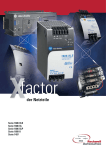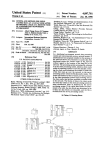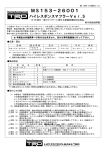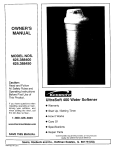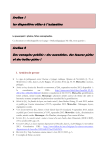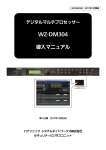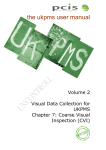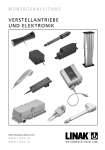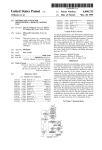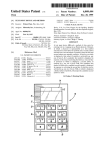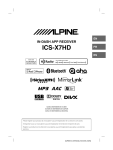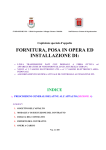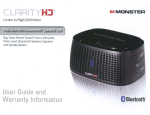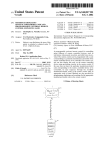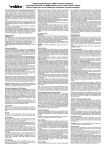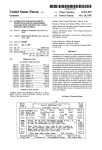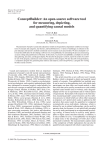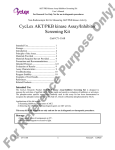Download Method and device for input of text messages from a keypad
Transcript
US005952942A
United States Patent [19]
[11] Patent Number:
Balakrishnan et al.
[45]
[54]
METHOD AND DEVICE FOR INPUT OF
WO90/02992
Australia .
Inventors: Sreeram Balakrlshnan, San Francisco;
Xixian Chen, Palo Alto; Y'u Dong,
3/1990
1015214 12/1991
1092186
1029760
9/1994
9/1995
MOllIlIalIl VIGW, all Of Callf.
1120695
4/1996
China _
1121601
5/1996
China .
1133450 10/1996
China _
_
[73]
Ass1gnee: Motorola, Inc., Schaumburg, I11.
[*]
Notice:
*Sep. 14, 1999
FOREIGN PATENT DOCUMENTS
TEXT MESSAGES FROM A KEYPAD
[75]
Date of Patent:
5,952,942
This patent issued on a continued prosecution application ?led under 37 CFR
China.
China‘
China _
319193A2
11/1988
European Pat. Off. ..... .. H04M 11/06
464726A2
689122A1
6/1991
1/1995
European Pat. Off. ...... .. GO6F 3/023
European Pat. Off. ........ .. G06F 3/02
1.53(d), and is subject to the tWenty year
patent term provisions of 35 U.S.C.
OTHER PUBLICATIONS
154(21)(2)-
Arnott, John L. and Javed, Muhammad Y., “Probabilistic
Character Disambiguation for Reduced Keyboards Using
Small Text Samples”, Argumentative and Alternative Com
[21] Appl. No.: 08/754,453
.
_
[22] Flled'
munication Sep. 1992, pp. 215—223.
NOV‘ 21’ 1996
Witten, I. H. (1982), “Principles of Computer Speech” (pp.
[51]
Int. Cl.6 ................................................... .. H03K 17/94
247—249), London: Academic Press.
[52]
US. Cl. ............................... .. 341/20; 341/22; 341/28;
HoroWitZ, Ellis and Sahni, Sartaj, “Fundamentals of Data
379/353; 379/354; 704/8; 704/10; 707/536;
Structures in Pascal”, Computer Science Press, pp. 512—520.
364/705.01; 345/171
[58]
Cormen, Thomas H. et al., “Introduction to Algorithms”,
Field of Search ................................ .. 341/20, 22, 28;
The MIT Press, pp. 469—471.
707/535, 536; 704/8, 2—4, 9, 10; 379/353,
354; 364/705.01, 709.12, 709.16; 345/168,
169, 171; 400/110
[56]
Ziran Input System User Manual, Ziran Software Limited.
References Cited
Primary Examiner—Michael Horabik
Assistant Examiner—Timothy EdWards, Jr.
U'S' PATENT DOCUMENTS
4,375,922
3/1983 Maegawa et al. .................... .. 400/110
4,689,743
8/1987
4,868,779
9/1989 Seto
570477932
9/1991 Hsieh .33...I.I...I.I.IIIIIIIIT400/110
chm
... ... ... ... ..
. . . . ..
5,319,552
11/1991
Chang ......... ..
6/1994 Zhong et al. .
5,617,314
4/1997
5,623,682
4/1997 Fukunaga -
5,634,134
5/1997 Kumai ct a1~
5,689,617
Zhong ......... ..
11/1997 Panako? et a1‘ '
Sado ................ ..
Attorney, Agent, or Firm—Hugh C. Dunlop
341/20
707/536
[57]
"" "
5,063,376
Pearl, Judea, “Heuristics; Intelligent Search Strategies for
Computer Problem Solving”, Addison—Wesley Publishing
Company.
ABSTRACT
A method of text entry into a device by activating keys of a
keypad (16), Where a key represents various Characters.
340/706
Input is delivered to a processor (30) corresponding to the
707/535
707/535
keys activated. A dictionary (33) is searched for candidate
combinations of characters corresponding to the keys acti
707/536
~~~~~ ~~ 704/8
vated. The candidate combinations are rank ordered, for
example using language model data and feedback (14, 38) is
" 395/264
provided to a user indicating at least a highest rank ordered
5,713,033
1/1998
400/110
5,745,876
4/1998 Kneser et al.
704/255
5,765,133
6/1998 Antoniol et a1. ..
704/355
.
.
.
candidate
combination.
5,818,437 10/1998 Groverr et al. ....................... .. 345/326
19 Claims, 6 Drawing Sheets
SEND NUMERIC SEQUENCE TO
COMPARE AGAINST ENG.
DICTIONARY
~14"
l
COMPARE WITH DICTIONARY.
FIND MATCHING WORDS AND
TRIGRAMS
'“150
ALL MATCHES CORRELATING
TO THE INPUT
ASSIGN PROBABILITIES TO EACH
MATCH THROUGH LANGUAGE MODEL
DISPLAY MATCH WITH HIGHEST ~180
PROBALILITY OF CORRELATING
TO INPUT
@200
U.S. Patent
Sep. 14,1999
5,952,942
Sheet 1 of6
14
/~13
I am late call me at 415
8211223 Jim
15\
17/\
12 \
— , *
A B c
D E F
1
2
3
G H I
J K L
M N O
4
5
6
P Q R S
T U V
W X Y Z
7
8
9
<<
CAPS
>>
>|<
O
#
16a’
/
18
/
\
k
19
U.S. Patent
Sep. 14,1999
Sheet 2 of6
33
5,952,942
34
31\\ \
//
DICTIONARY
LANGUAGE
MODEL DATA
/32
RAM
/ 16
W30
INPUT
PAD
MICRO
PROCESSOR
3a
DISPLAY
’14
PREss + HOLD
40
# >>
44
CYCLE
- THROUGH CHOICES
STANDARD
ENTRY MODE
SUPERVISED
ENTRY MODE
NUMERIC
ENTRY MODE
U.S. Patent
Sep. 14,1999
Sheet 3 of6
5,952,942
SUBROUTINE '"130
T
SEND NUMERIC SEQUENCE TO
COMPARE AGAINST ENG.
DICTIONARY
H140
T
COMPARE WITH DICTIONARY.
FIND MATCHING WORDS AND
TRIGRAMS
H150
T
ALL MATCHES CORRELATING
TO THE INPUT
160
T
AssICN PROBABILITIES TO EACH |~170
MATCH THROUGH LANGUAGE MODEL
T
DISPLAY MATCH WITH HIGHEST
PROBALILITY OF CORRELATING
TO INPUT
FIG. 4
H180
U.S. Patent
Sep. 14,1999
Sheet 4 0f 6
5,952,942
f--------------------------
m2\
5 % 530%;
_1
55Em$6;
{2
Q3
$1
aHm.o5>02
m|_0> IonmT; moHI
2:EGz2H
>
PJ2 M-Ea
"I ' J
/
c:
U.S. Patent
Sep. 14,1999
Sheet 5 of6
5,952,942
306
SCROLL
' RIGHT
SCROLL
LEFT
CHARACTER
SELECTION
MODE
STANDARD
304
ENTRY MODE
302
PRESS-HOLD
0-9
PUNCTUATION
AND ALPHANUMERIC
ENTRY MODE
310
FIG. 6'
/ YONG DIAN
HUA
JIAN
PAN
SHU
RU
HAN
ZI
482
5426
726
748
78
426
94
500
/w 9664 3426
502
FIG. 7
5,952,942
1
2
METHOD AND DEVICE FOR INPUT OF
TEXT MESSAGES FROM A KEYPAD
non-alpha keyboard, the user has to enter a speci?c combi
nation of numbers and/or symbols to indicate the Word call.
By Way of example for a user to enter the Word call the user
FIELD OF THE INVENTION
must enter the folloWing: 2***; 2*; 5***; 5***; #. Such a
method of inputting is very restrictive, time consuming, and
editing is dif?cult and sloW.
This invention relates generally to a data entry method
and apparatus, and more particularly to a method and
apparatus for inputting text messages from a keypad, for
Therefore a need exists to provide a user With a simple
straightforWard method and apparatus for inputting alpha
example a numeric keypad.
numeric text through a non-alpha, numeric, or other keypad
BACKGROUND OF THE INVENTION
10
personal communicating devices With optimum functional
choices are available and easily input.
ity such as pagers, cellular phones, and other personal
communicator devices, and the desire to automate homes
through combinations of telecommunications and cable
Various preferred embodiments of the invention are noW
15
operate a variety of appliances or control a variety of
applications; the need and desire to enter alphanumeric text
BRIEF DESCRIPTION OF THE DRAWINGS
through non-alpha or numeric keypad is ever increasing.
FIG. 1 is a front vieW of an illustrative text entry device
In the United States of America it is standard for every
telephone keypad to have letters as Well as numerals dis
played on the keys. Thus, the key representing the numeral
“2” has the letters A, B and C displayed and the key
25
suitable to receive input in accordance With the present
invention.
FIG. 2 is a block diagram detailing internal circuitry of the
device of FIG. 1.
FIG. 3 is a state diagram illustrating operation of the
device of FIG. 1 in accordance With a ?rst embodiment of
the invention.
Which correspond to the digits on the keypad. Thus, for
example, a railWay company With the name “Amtrac ” can
FIG. 4 is a How diagram illustrating operation of the
acquire the telephone number 268 7225 and can advertise to
customers that the company’s telephone number can be
device of FIG. 1 in a principal entry mode of FIG. 3.
FIG. 5 is a How diagram illustrating further details of the
dialed by activating the keys With the letters A-M-T-R-A
C-K. Dialing these letters Will result in only one digital
sequence, but one digital sequence can be represented by
many letter sequences.
In the telecommunications ?eld, methods of name selec
described, by Way of example only, With reference to the
accompanying draWings.
Where smart rooms Will have one or more small devices that
representing the numeral “3” has the letters D, E and F etc.
It is common to represent a telephone number by the letters
having feWer keys than the desired alphabet; and the need
exists to provide a system that is not restrictive to direct
correlation or a specialiZed domain, ie where a variety of
With the increasing desire to carry smaller and smaller
operation of FIG. 4.
FIG. 6 is a state diagram illustrating operation of the
35
tion are knoWn Which use a numeric keypad. For example,
it is knoWn in a voice mail system to select a user’s voice
device of FIG. 1 in accordance With an alternative embodi
ment of the invention.
FIG. 7 is an example of nine pinyin entries With corre
sponding digit streams and examples of selected Chinese
mailbox by keying in from a remote telephone the ?rst feW
letters of a user’s name, as a result of Which a short digit
characters Which can be entered by operation of the alter
native embodiment of the invention.
stream is delivered to the voice mail system. The voice mail
system compares the input digit stream With a limited set of
FIG. 8 is a state diagram alternative to that of FIG. 6.
options in a look-up table. Sufficient digits must be entered
to uniquely identify the desired user. Similarly, automated
DETAILED DESCRIPTION OF PREFERRED
EMBODIMENTS
customer service systems can use this form of text entry. For
example an airline information system can request the ?rst
45
three letters of a destination airport and, notWithstanding
ambiguities in the letters to be represented by the digits
delivered, it can uniquely identify an airport from only three
digits because it has a limited “dictionary” of airport names
model data stored in memory to generate at least one entry
selected by probability of corresponding to the input; and
providing user feedback of the entry having a likelihood of
corresponding to the input.
from Which to seek a match. The same approach can be used
in a telephone speed-dial look up arrangement. A name can
be selected from a limited list of names stored in a telephone
terminal and a number can be dialed associated With the
Particularly, a method of text entry into a device is
name selected.
Various other approaches for entering alphanumeric input
Generally, a method is noW described comprising the
steps of: comparing input With dictionary and language
55
through a non-alpha, numeric only, or other type of keypad
having feWer keys or buttons than the corresponding alpha
provided comprising the steps of: activating keys of a
keypad, Where a key represents a plurality of characters;
delivering input to a processor corresponding to the keys
activated; searching a dictionary for candidate combinations
of characters corresponding to the keys activated; rank
ordering the candidate combinations; and providing feed
bet have been developed or are knoWn. Many of these
methods take advantage of the letters displayed on the
back to a user indicating at least a highest rank ordered
standard US telephone keypad. HoWever, often the methods
associated With the alphanumeric text through the keypad
letters or to pictographic or grapheme characters.
candidate combination. Here, “character” refers generally to
It may be noted that the dictionary is searchable by
combinations of characters, Where the characters by Which
are cumbersome and dif?cult to edit. In addition, typically
the entry must be restricted or entered in a speci?c manner
it is searchable are the same as the characters represented on
such that there is only one option per sequence of input.
the keys.
More speci?cally, there is a direct correlation for a speci?c
input to a speci?c letter of the alphabet or a symbol. For
example, if a user Wants to input the Word “call” through a
65
A method and apparatus are also described for input of
text through a keypad having feWer keys than the number in
the desired alphabet alone or in combination With numbers
5,952,942
3
4
and other symbols. Recognition of the input is preferably
entry device, English Words and letter trigrams. The lan
guage model data 34 includes unigram Weight values for the
Words and letter trigrams stored in the dictionary. Optionally
correlated With the most likely text selection from a
dictionary, language, or compilation of data having an
the data 34 also includes Word bigram and even Word
trigram data. Other language model information can be
unrestricted set of characters.
Language model data is preferably used to rank order the
candidate combinations in order of probability, i.e. likeli
hood of usage in a given language. Such language model
data preferably comprises character combination data. The
character combination data comprises, for example, Word
unigram data, letter trigram data, or Word bigram or trigram
stored With unigram Weight values 34. An optional loud
speaker 38 is shoWn coupled to the microprocessor.
Referring to FIG. 3, the microprocessor 18 is shoWn as
having three principal modes of operation for data entry (it
10
(or n-gram) data or, for example, in a Chinese or other
is standard entry mode 40 and associated With this mode is
cycle mode 42. The other modes of data entry are numeric
pictographic or grapheme language version to be described,
it may comprise pinyin letter trigram data, pictographic or
grapheme character unigram data, pictographic or grapheme
character bigram (or n-gram) data or Word (i.e. pictographic
or grapheme character combination) bigram (or n-gram)
entry mode 46 and supervised entry mode 48. Standard entry
15
embodiment of recogniZing alphanumeric input in standard
mode through a non-alpha or numeric keypad is illustrated.
The example Will be considered Where the digit sequence 2
2 5 5 is entered. As illustrated, the ?rst input digit “2” is
displayed in a display area of a device and the at least one
likely entry presented in the display area can be edited
through input of a keypad.
received in step 120 by pressing brie?y and releasing the
Referring noW to the ?gures, FIG. 1 illustrates a general
other data entry device such as a Wireline telephone, pager
corresponding key . Subroutine 130 Will be disregarded for
the present as it relates only to entry of “#>>” and “<<*”. In
25
nary 33. Thus, each entry is appended by microprocessor 30,
as it is received, With previously entered digits and the
various possible corresponding letters are compared in step
150 With Words from the dictionary 33.
The ?rst digit “2” can correspond to A, B or C. The
display area 15 and an area 17 for displaying Word, letter
combination or character alternatives. The keypad 16 has
35
arrangements, for example for greater ergonomic ef?ciency,
comparison of step 150 Will search for Words and
(optimally) letter trigrams beginning With the letters A, B or
C. In the case of the ?rst entered digit, all three options (A,
B and C) are possible ?rst letters of a Word and step 150
determines positively that at least one match is found. (Note
that if step 150 reveals no candidate Words then step 155
but the illustrated layout is preferred on account of estab
instead looks for candidate letter trigrams). In step 160 all
possible matches correlating to the input are identi?ed and
kept active for further steps in the process. In step 170,
probabilities are assigned to the active matches using the
language modeling data 34 and in step 180 the active match
or matches With the highest probability are displayed in
lished use. The key bearing the digit “1” has the punctuation
marks “—”, “?” and “*” displayed thereon. The loWer left
hand key 18 has the symbols “<<” (meaning “backspace” or
“scroll left” as is explained beloW) and * (referred to as
“star”). The loWer right hand key 19 has the symbols “>>”
(meaning “enter” or “scroll right” as is explained beloW) and
“#” (referred to as “pound”).
step 140 the numeric sequence entered so far is sent on to the
next step for comparison against the contents of the dictio
or personal digital assistant or telecommunications device)
having a keypad is illustrated as generally depicted by the
reference numeral 10. The cellular telephone 10 depicted
comprises a housing 12, a display 14 and a keypad 16
through Which input is received. The display 14 has a text
tWelve keys With digits 0—9 displayed thereon in a standard
layout. Also displayed in a standard layout are letters of the
Roman alphabet A—Z. These letters can be arranged in other
mode 40 is noW described in detail, With the other modes
being described later.
Referring noW to FIG. 4, a How diagram of a preferred
data and the like.
In a preferred embodiment, at least one likely entry can be
and preferred embodiment of apparatus in accordance With
the present invention. An example of a cellular telephone (or
may have many other modes and functions not relevant to
the present invention). The ?rst principal mode of data entry
45
In the preferred embodiment illustrated, the English
alphabet is used. Alternatively, various other alphabets may
be used in accordance With the preferred embodiments of the
present invention, such as Chinese phonetic alphabets or
Russian or Asian alphabets. In the preferred embodiment of
display area 17. In the case Where only one digit has so far
been entered, there is suf?cient space in display area 17 to
display all three active matches A, B and C. In step 200 the
program returns to step 120 and aWaits the next digit input.
When a second input “2” is received, the comparison 150
Will noW yield Words and trigrams beginning With AA, AB,
AC, BA, BB, BC, CA, CB, and CC. If a third input, 5, is
received, the comparison 150 could potentially yield entries
the present invention illustrated in the ?gures, the input
device is a keypad having feWer individual keys than the
number of letters in the alphabet. Therefore, the alphabet is
beginning with AA], AAK, AAL, ABJ, ABK, ABL, BAJ,
BAK, BAL, BBJ, BBK, BBL, BCJ, BCK, BCL, CAJ, CAK,
separated into various sequences Where a single numeral and
CAL, CBJ, CBK, CBL, CCJ, CCK, and CCL, but some of
a series of letters or symbols are represented on a single key, 55 these trigrams may not appear in the English language and
or block of input, of the keypad or other input device.
Pressing of a key delivers a digit, but the digit can represent
Will be omitted by step 150. If a fourth input, 5, is received,
one of a plurality of letters or characters.
Referring to FIG. 2, the cellular telephone 10 is illustrated
as having a microprocessor 30 coupled to the input pad 16
and to the display 14 using standard input and output drivers
as are knoWn in the art. Also coupled to the microprocessor
30 are a ?rst memory 31 Which is preferably electrically
erasable read-only memory (EEPROM) and a second
memory 32 Which is preferably random access memory
(RAM). In the EEPROM memory is stored a dictionary 33.
The dictionary 33 includes, for an English language data
65
Words beginning With AAJJ, AAJK, AAJL, AAKJ, AAKK,
AAKL, AALJ, AALK, AALL, ABJJ, ABJK, ABJL, ABKJ,
ABKK, ABKL, ABIJ, ABLK, ABLL, BAJJ, BAJK, BAJL,
BAKJ, BAKK, BAKL, BALJ, BALK, BALL, BBJJ, BBJK,
BBJL, BBKJ, BBKK, BBKL, BBLJ, BBLK, BBLL, BCJJ,
BCJK, BCJL, BCKJ, BCKK, BCKL, BCLJ, BCLK, BCLL,
CAJJ, CAJK, CAJL, CAKJ, CAKK, CAKL, CALI, CALK,
CALL, CBJJ, CBJK, CBJL, CBKJ, CBKK, CBKL, CBLJ,
CBLK, CBLL, CCJJ, CCJK, CCJL, CCKJ, CCKK, CCKL,
and CCLJ, CCLK, and CCLL are possibilities to be searched
in the dictionary (less any combinations ruled out in the
5,952,942
5
6
previous round of comparison). From this list of all
combinations, the dictionary is compared and any matches
are identi?ed in step 150. In the example presented, the
With a large number of alternatives is ergonomically inef?
cient. For these reasons, a language model is used in step
170 to assign a probability to each of the matched entries
identifying the likelihood that the entry corresponds to the
intended input. Preferably, step 170 causes the entry With the
entries With matches found in the dictionary are BALK,
BALL, CALK, and CALL.
Alphanumeric recognition data can be stored in the
highest probability of correlating to the alphanumeric input
to be displayed in area 17 of the display 14 of the device 10.
memory 31.
In the preferred embodiment, the dictionary 33 represents
a plurality of Words or symbols and is preferably stored as
a trie, as is described in “Fundamentals of Data Structures in
10
Pascal” by E. HoroWitZ and S. Sahni, published by Com
puter Science Press, pages 512—520. The input is compared
against the dictionary and preferably as each input is
received the comparison is continually updated. In a pre
ferred embodiment, a comparison that Will not yield a match
is eliminated and that combination and any and all further
combinations that include that combination are also then
ignored or eliminated. For example purposes only, if a ?rst
and a second input are 2 2, and the comparison With the
or some other number up to, preferably, a maximum of 10
candidates).
15
An advantage of the present invention is that it alloWs for
ambiguous input and converts that input to a Word or
alphanumeric value that has the highest probability or like
lihood of correlating to the input.
Referring noW to FIG. 5, details of the subroutine 130 of
FIG. 4 are shoWn.
dictionary yields BB, and the dictionary does not have any
entries that Would match BB, all further input that Would
begin With BB combinations is eliminated or ignored. For
example, if the third is 5, such that the input noW is 2 2 5,
all the entries such as BBJ, BBK, BBL, etc. are ignored or
eliminated and not compared to the dictionary.
In accordance With a preferred embodiment of the present
This is achieved by looking up and comparing unigram
Weighting values from language model data 34 (and/or other
language model data) for the different candidate alternatives
and selecting the most likely candidates (e.g. four candidates
25
If, folloWing entry of one or more digits, and display of
the candidate matches on display area 17, key 19 is pressed,
bearing the markings “#>>” the program proceeds to step
184. Step 184 represents the commencement of an end-of
Word mode, terminating the entry of the current Word and
causing it to be displayed in text display area 15 folloWed by
a space.
invention, a breadth-?rst search is used to accelerated the
At this point in the process, the highest priority match is
displayed in alternatives display area 17 of display 14. The
comparison of the input to the stored dictionary entries.
Advantages of this type of search are that it reduces the time
for comparison and provides results With a greater accuracy
of correlating to the input. Breadth-?rst searches are
program aWaits neW date entry at step 190. If the Word or
described in “Heuristics—Intelligent Search Strategies for
is displayed, but BALL is desired, pressing (brie?y) and
character displayed in display area 17 (the highest ranked
match) is not the desired Word or character—e.g. if CALL
Computer Problem Solving” by Judea Pearl, published by
Addison-Wesley Publishing Company, page 42 et seq. and
“Introduction to Algorithms” by Thomas H. Cormen et al.,
35
published by MIT. Press and McGraW-Hill at page 469 et
seq.
releasing key 19 (#>>) causes step 193 to cycle to the next
choice. With each press of key 19, steps 192 and 193 cause
the next rankordered choice to be displayed in alternatives
display area 17 and in text display area 15 (eventually
returning to the original highest rank-ordered choice). If, in
step 190, the input key 18 (<<*) is pressed, step 198 causes
In a preferred embodiment of the present invention, the
dictionary Whose contents are stored as a trie is searched
the entire sequence of digits since the last space (the entire
using a beam search. Various techniques for beam searches
Word or character) to be deleted and the program recom
mences at step 120, Where a neW input can be received and
the Word can be re-entered. If the entry at step 190 is neither
are knoWn in the art. For present purposes, a beam search is
a breadth-?rst search With limited breadth, Where only, say
of keys 18 and 19 then logically it must be another of the
100 possible matches are considered at any moment. This
feature is particularly advantageous because spelling errors
are permitted. Preferably, a restriction is established limiting
45
the number of alternatives that Will be searched.
More preferably, a restriction is established Which
restricts or eliminates all alternatives from the dictionary
that are returned Which fall beloW a predetermined “score.”
The score that is selected Will vary depending upon the
parameters that are determined to be the most signi?cant for
the application for Which the invention is being used. In a
preferred embodiment, an alternative receives a high score
if the entry corresponds to an entry in the dictionary. If,
reached. This entry is interpreted to be the start of a neW
Word or character. In step 197 the end-of-Word mode ends
and a neW Word (or character) begins. The program proceeds
to step 140 for processing of the neW digit stream repre
senting the neW Word or character.
Other steps can be introduced. For example press-and
hold activations of various keys during the execution of
steps 182—198 can be given additional meanings and func
tions.
55
hoWever, the alternative does not correspond to an entry in
the dictionary, the alternative is given a loW score.
More preferably, each alternative that does not match an
entry in the dictionary is eliminated. Preferably, for each
alternative that does match an entry in the dictionary, the
alternative is compared to a unigram language model to
determine the frequency of occurrence of that alternative.
In the preferred embodiment, all input that matches or
corresponds to an entry in the dictionary at step 150 of FIG.
4 is returned to the memory 32. In many instances, there are
too many possible matches for all matches to be displayed
in alternatives display area 17. Moreover, presenting a user
keys of keypad 16, representing a digit 0—9 and step 197 is
65
If, folloWing step 120, key 18 is pressed, step 186 causes
the program to proceed to step 188 and the last digit entered
is deleted. The program then continues With step 140 and the
numeric sequence so far entered (omitting the last digit) is
delivered to comparison step 150 for processing as before.
It Will, of course, be appreciated by one of ordinary skill
in the art of computer programming that the steps illustrated
in FIGS. 4 and 5 can be implemented in many different
forms and do not have to be implemented in the sequences
shoWn.
If at any time in mode 40 (except betWeen steps 184 and
195) the desired Word to be entered in the text display area
15 is not the highest priority Word, key 19 can be pressed
5,952,942
7
8
doWn and held doWn for a predetermined time (eg 1.5
only letter trigrams to select the next candidate character.
seconds) and this Will cause cycle mode 44 (FIG. 3) to
When key 19 is pressed, supervised data entry mode ends,
the displayed (or in the preferred alternative the highest
operate and the candidate matches in display area 17 Will
cycle through (cycling to the left if more than one is
priority displayed) Word is stored in memory 32 and dis
displayed). Upon release of the respective button, standard
played in text display area 15 and the program returns to
entry mode 40 resumes. Pressing-and-holding of key 19
betWeen steps 184 and 195 can be given a different meaning
standard entry mode 40. Supervised entry mode is particu
larly useful for entry of Words not included in the dictionary
(because pressing and releasing that key at that time already
operates the function of cycling through the choices). It is
preferred that here pressing-and-holding key 19 has the
33 and for entry of names
10
In the embodiment described above, a predetermined key
(e.g. “#”) is preferably to select and enter the highest rank
effect of entering a space in text display area 15.
ordered candidate combination.
When the desired Word is displayed in the left-most
position in the display area 17, it can be selected by pressing
Amemory (e. g. EEPROM 31 or a separate computer disk)
can be provided having instructions and data stored therein
that, When executed, cause the microprocessor 30 to com
prise: an input; a dictionary 33; language model data 34; a
search algorithm 150, to search the dictionary for candidate
combinations of characters corresponding to digits received
key 19 brie?y (less than the predetermined time) and releas
ing it. This action delivers the Word to memory 32 and to text
15
display area 15 as described above.
If the display area 17 is small in comparison to the length
of the candidate matches, there may be only one candidate
displayed at one time and key 19 Will cause the next
candidate (in rank order of likelihood of selection) to be
at the input (input from input pad 16); a rank ordering
function 170 that rank orders the candidate combinations
20
displayed.
The standard mode of text entry 40 described and illus
trated in FIGS. 4 and 5 alloWs for very fast text entry from
multiplexed keys Where each key represents a plurality of
letters or characters. For example, 65% of English text is
Written using only 100 Words. 91% of these Words can be
entered Without having to use keys 18 and 19 to scroll
25
beyond the ?rst presented match. Thus the arrangement
described comes close to meeting a goal of one keystroke
entry per letter.
30
Where the Words to be entered are all included in the
Roman alphabet A—Z.
35
used to determine the frequency of tWo consecutive Words
is as shoWn in FIG. 1. (Alternatively the digits 7 through 0
can represent <p r s>, <t u v>, <W x y>, <q Z> respectively
memory 31, especially When operating in the English
or digits 7 through 9 and digit 1 can represent <p r s>, <t u
language, on account of the very large number of possible
bigrams. Atrigram language model can be used to determine
v>, <W x y>, <q Z> respectively.)
Referring to FIG. 6, a mode diagram for a program
the frequency of three Words occurring together.
operated by microprocessor 30 is shoWn for this embodi
45
310 is provided
In standard entry mode 300, a user enters the pinyin of
50
released While a numeral is displayed, numeric entry mode
46 is activated. If it is released While a letter is displayed,
55
pressed. Thus the number 8211223 shoWn in FIG. 1 can
easily be entered by one long press of key “8” folloWed by
a short press of each of the subsequent keys.
Upon pressing key 19 the program returns to standard
data entry mode 40.
operates in the same Way as standard entry mode 40 but uses
described above With respect to entry of English Words. (For
veri?cation, a digit string is displayed in a small WindoW 13
Which is located at the top right of the display 14). He can
press key 18 to delete a digit that is Wrong. When ?nished,
he presses key 19. The program then proceeds to character
selection mode 302 and displays in character selection area
17 of the display the top 10 Chinese characters that have the
pinyin entered. The characters are rank ordered based on the
60
language model data 34. A number from 0 to 9 is displayed
under each Chinese character. The user can select the
Chinese character he Wants to input by pressing its corre
When supervised data entry mode 48 is entered, each
subsequent letter can also be entered by a similar press-and
scroll method of letter selection (as is knoWn in the art).
As a preferred alternative, supervised data entry mode 48
each Chinese character he Wants to input by using the
telephone keys marked a,b,c,d, . . . in the same manner as
displayed in sequence (or 2-A-B-C etc.). If the key is
supervised entry mode 48 is activated.
Once numeric entry mode 46 is activated, every subse
quent key press is assumed to be a number, until key 19 is
ment of the invention. There is a standard entry mode 300
With an associated character selection mode 302. Character
selection mode has scroll left and scroll right modes 304 and
306 as sub-modes. An alternative alphanumeric entry mode
holding a key corresponding to the digits 0—9. Upon pressing
“2” key causes the characters A-B-C-2-A-B-C-2 to be
So a pinyin based Chinese keypad data entry device can
have the same keypad layout as that shoWn in FIG. 1. The
mapping table of telephone digit keys and 26 English letters
occurring together and to rank order the candidate matches
accordingly. This embodiment, hoWever, can require a large
and holding one of these keys, the different multiplexed
characters (digit and letters) are displayed in cyclic order in
the display area 17. For example pressing and holding the
simple and fast entry of Chinese characters. In this embodi
ment it is preferred (but not essential) that one of a plurality
of keys (e.g. 0—9) is activated to select and enter one of a
plurality of rank ordered candidate combinations.
Since the mid 1950s, a standard phonetic representation
of Chinese characters has been adopted knoWn as “pinyin”.
Word, is made up from combinations of the 26 letters of the
and 44) can be used continuously to enter text.
In alternative embodiment of standard entry mode 40, a
In accordance With preferred features of the present
invention, alternative data entry modes are provided.
Numeric entry mode 46 can be entered by pressing and
at least a highest rank ordered candidate combination.
There noW folloWs a description of hoW the above
embodiment of a data entry device can be modi?ed for very
The pinyin for each Chinese character, like each English
dictionary standard entry mode 40 (and associated modes 42
bigram language model (tWo-Word combination model) is
according to the language model data; and an output (to
display 14 or loudspeaker 38) to provide feedback indicating
sponding number displayed. For example, if the Chinese
65
character marked by 3 is the desired one, he simply presses
the key marked by 3 nto put it in the text area 15 of the
display 14 and store it in memory 32. The program then
returns to standard entry mode 300.
5,952,942
10
ters and these are displayed in display area 17. The user can
standard mode 300, When pressing and holding key 0 for a
predetermined time (eg 1—5 seconds), the program enters
the Chinese punctuation and symbol entry mode 620 and
displays in character selection area 17 of the display digit 0,
revert to the previous list of 10 characters by pressing key 18
space, punctuation marks, and other symbols.
If the user can not ?nd the Chinese character he Wants to
input in the display area 17, he can press key 19 again, then
mode 304 of the program gives a list of another 10 charac
to activate mode 304. Since the dictionary 33 contains every
possible Chinese character, the user can alWays ?nd the right
character he Wants to input.
If the pinyin the user entered is not a legitimate pinyin of
a Chinese character, the system displays nothing and gives
a beep through the loudspeaker 38 or leaves the digit stream
E.g. :
10
0123456789
A number from 0 to 9 is displayed under each symbol (or
displayed unchanged in WindoW 13 and gives a beep.
Once the user has entered the pinyin folloWed by “#” key
item). The user can select the Chinese symbol he Wants to
19, the tWo editor keys “*” and “#” become the selecting
keys for the top 10 candidate list, one is forWard, the other
is backWard. The user must make his selection by pressing
one of 10 telephone digit keys even if he can not ?nd the
Chinese character he Wants to input. This returns the opera
tion to standard entry mode 40 and key 18 can be used to
delete the entered character and start again With pinyin entry
for the desired character.
user cannot ?nd the symbol he Wants to input, he can press
input by pressing its corresponding number displayed. If the
15
key 19, then mode 620 of the program gives a list of another
10 Chinese symbols and these are displayed in the display
area 17. The user can revert to the previous list of 10
symbols by pressing key 18 to activate mode 620. There are
more than 600 Chinese symbols.
The system uses keys 1—9 to enter ASCII symbols, Which
include English alphanumerics, punctuation marks, and
An example of nine pinyin entries, With corresponding
other symbols. In standard mode 300, When pressing/
holding key 1 for a predetermined time (eg 1—5 seconds),
digit streams 502 and examples of selected characters 504
corresponding to those pinyin entries is shoWn in FIG. 7.
the program enters mode 610 and displays digit 1, space,
There are four frequently used punctuation marks “,” “ ” 25
punctuation marks, and other ASCII symbols.
“.”, “?”, “ !” marked in key 1. The system uses the press/hold
mode to enter one of them. When the user Wants to input the
E.g. .
punctuation, he presses and holds key 1. The program enters
mode 310. Then the digit 1 and the four punctuation marks
0123456789
“,”, “.”, “. ’, “!” are then displayed on the screen one by one.
The user can select the punctuation he Wants to input by
A number from 0 to 9 is displayed under each symbol (or
release key 1 When it is being displayed.
In a manner similar to the input of punctuation, alphanu
meric entry mode 310 is entered in a press/hold manner to
enter digits and Roman letters. For example, if the user
Wants to enter the Roman character M, he presses and holds
item). The user can select the ASCII symbol he Wants to
input by pressing its corresponding number displayed. If the
user cannot ?nd the symbol he Wants to input, he can press
digit 6, the small cases of these three characters and the
key 19, then mode 610 of the program gives a list of another
10 ASCII symbols and these are displayed in the display area
17 The user can revert to the previous list of 10 symbols by
pressing key 18 to activate mode 610.
capital cases of these three characters one by one. The user
then releases the key When he sees the character M on the
Other digits and Roman letters can also be entered in a
press/hold manner. For example, if the user Wants to enter
35
key 6 Which is marked by M, N, 0. The system then displays
Roman character M, he presses and holds key 6 Which is
marked by M, N, O. The system then enters mode 610 from
mode 300 and displays digit 6, the small and capital cases of
English letters m, n, 0, like this
screen.
Referring to FIG. 8, a state diagram alternative to that of
FIG. 6 is shoWn. In this diagram, standard entry mode 300
as Well as Chinese (or other pictographic or grapheme)
character selection mode 302 and scroll right and scroll left
modes 304 and 306 are unaltered. Mode 310 of FIG. 6 is
45
split into tWo alternative modes in FIG. 8, these being
Chinese punctuation and symbol mode 620 and ASCII
symbol entry mode 610. Mode 620 is reached from mode
300 by pressing and holding key “0”. Mode 610 is reached
from mode 300 by pressing and holding one of keys “1—9”.
These modes 620 and 610 have respective scroll right and
scoll left modes 621, 622, 611 and 612 similar to modes 306
and 304. Additionally insert return mode 601 is provided
Which is reached from mode 300 by pressing key 19 (#)
Without ?rst entering any pinyin. Mode 302 is, in FIG. 8,
012345 67
The user can then select the capital letter M by pressing key
55
Words or characters. Mode 632 is the same as mode 44 in
only reached by pressing key 19 (#) after entering pinyin.
FIG. 1 and mode 631 is similar.
The arrangement of FIGS. 1, 2 and 6 or 8 can be used to
Modes 631 and 632 are added (scroll right and scroll left
respectively) Which can be reached from mode 300 by
enter text using Zhuyin phonetic Chinese symbols instead of
pressing and holding respective keys 19 and 18 for a
pinyin (loWer case Roman) symbols, by suitably displaying
predetermined time (eg 1.5 seconds).
Mode 620 is useful because, in Chinese, there are about
500 punctuation and other symbols that do not form parts of
Words, but stand alone. These can be selected by pressing
“0” and scrolling left or right to select the desired symbol.
The system uses key 0 to enter Chinese punctuation marks
and other Chinese symbols, such as space, slash, etc. In
4 and the program returns mode 600. If the user accidentally
presses and holds the keys 2 to 9, and he does not Want to
enter any Roman letters, he can press key 7 to return to the
standard mode 300 Without entering any Roman letters.
Mode 601 alloWs a carriage return to be entered betWeen
the 37 Zhuyin phonetic Chinese symbols on 10 telephone
keypad keys and suitably providing matching dictionary and
language model data.
65
It Will be apparent to those skilled in the art that the
disclosed invention may be modi?ed in numerous Ways and
may assume many embodiments other than the preferred
forms particularly set out and described above. For example,
5,952,942
11
12
7. A method comprising the steps of:
receiving input data from a keypad area of a device having
a set of keys, each key representing a plurality of
instead of providing a display 14 and user feedback through
area 17 of the display, synthesized voice can be output
through the speaker 38 to provide user feedback of a
candidate match. Additionally, the input pad 16 and loud
characters such that activation of a key generates an
speaker 38 can be remote from the microprocessor 30 and its
memories 31 and 32, providing remote data entry. This
arrangement is particularly useful for alloWing a standard
telephone handset to be used for teXt entry, for example for
entering paging messages to a paging system from a remote
location. Accordingly, it is intended by the appended claims
ambiguous input signal having a probability of repre
senting any one of the plurality of characters for that
key;
10
to cover all modi?cations of the present invention that fall
its equivalents.
8. A method comprising the steps of:
15
steps of:
acters such that activation of a key generates an
ambiguous input signal having a probability of repre
senting any one of the plurality of characters for that
key;
delivering input to a processor corresponding to a set of
plural keys activated;
identifying candidate Words from the dictionary corre
searching a dictionary for a set of alternative characters in
a second alphabet, each alternative character ambigu
25
second alphabet characters in order of probability; and
the display area through input of the keypad area.
9. A method of processing keypad entry into alphanu
meric text, comprising the steps of:
35
receiving input as a sequence of numeric values;
converting the sequence of numeric values to at least one
alphanumeric unit;
comparing the at least one alphanumeric unit With a
one of a plurality of rank ordered candidate second alphabet
characters.
4. The method of claim 1, Wherein the language model
data comprises unigram data.
5. The method of claim 1, Wherein the language model
45
a keypad, said keypad having an input area of discrete
dictionary to identify candidate Words likely to repre
sent the input;
assigning through Word bigram data a probability to each
of the candidate Words; and
displaying a candidate Word having a highest probability.
10. A device comprising:
a keypad, said keypad having an input area and a display
area, said input area con?gured to receive numeric
input;
keys, each key representing plural characters in a ?rst
alphabet, and a display area, said input area con?gured
to generate numeric input upon activation of the keys;
display processing circuitry for presenting a graphical
image on the display;
a memory having at least alphanumeric recognition data,
including Word bigram data stored therein; and
display processing circuitry for presenting a graphical
image of a second alphabet ideographic character on
the display;
a memory having at least alphanumeric recognition data
stored therein; and
least one likely candidate Word having a highest prob
ability of representing the input data;
providing feedback to a user indicating at least a highest
data comprises letter trigram data.
6. A device comprising:
sponding to the input data;
identifying, using Word bigram language model data, at
storing the at least one likely candidate Word in memory;
displaying the at least one likely candidate Word in a
display area of the device; and
editing the at least one likely candidate Word presented in
of usage in a given language to order the candidate
rank ordered candidate second alphabet character.
2. The method of claim 1, further comprising the step of
activating a predetermined key to select and enter the
highest rank ordered candidate second alphabet character.
3. The method of claim 1, further comprising the step of
activating one of the keys of the keypad to select and enter
comparing input data received from a keypad area of a
device With a dictionary, the keypad area comprising a
set of keys, each key representing a plurality of char
activating keys of a keypad, Where a key represents a
plurality of characters in a ?rst alphabet;
ously corresponding to the set of plural keys activated,
to thereby provide candidate second alphabet charac
ters;
rank ordering the candidate second alphabet characters
utiliZing language model data indicative of likelihood
likely entry likely to represent the input data; and
displaying the at least one likely entry in a display area of
said device.
Within the true spirit and scope of the present invention and
What is claimed is:
1. A method of teXt entry into a device comprising the
comparing the input data With a dictionary and Word
bigram language model data to identify at least one
55
digital processing circuitry for comparing the numeric
input With the alphanumeric recognition data to provide
to the display processing circuitry candidate recogni
digital processing circuitry for comparing the numeric
tion information including at least one likely candidate
input With the alphanumeric recognition data and for
rank ordering the candidate second alphabet characters
utiliZing probability data indicative of likelihood of
Word having a highest probability of corresponding to
the numeric input value, as determined by the Word
usage in a given language to order the candidate second
11. A method of teXt entry into a device comprising the
alphabet characters in order of probability to provide to
steps of:
activating keys of a keypad, Where a key represents a
plurality of characters and activation of each key gen
erates an ambiguous input signal having a probability
bigram data.
the display processing circuitry candidate recognition
information including at least one likely candidate
second alphabet ideographic character having a highest
probability of corresponding to the numeric input
value.
65
of representing any one of the plurality of characters for
that key;
5,952,942
14
13
16. The method of claim 15, further comprising the step
delivering input to a processor corresponding to the keys
activated;
of:
searching a dictionary for Words corresponding to the
keys activated to provide candidate Words;
rank ordering the candidate Words utilizing Word bigram
editing the candidate Word having the highest probability.
5
language model data to order the candidate Words in
order of probability; and
18. A device comprising:
a keypad, said keypad having an input area of discrete
providing feedback to a user indicating at least a highest
rank ordered candidate Word.
12. The method of claim 11, further comprising the step
of activating a predetermined key to select and enter the
highest rank ordered candidate Word.
13. The method of claim 11, further comprising the step
of activating one of the keys of the keypad to select and enter
one of a plurality of rank ordered candidate Words.
14. A teXt entry device comprising: a keypad having a set
keys, each key representing a plurality of characters,
and a display area, said input area con?gured to receive
numeric input such that activation of a key generates an
ambiguous input signal having a probability of repre
senting any one of the plurality of characters for that
15
image on the display;
a memory having at least alphanumeric recognition data
stored therein; and
digital processing circuitry for comparing the numeric
guage model data; an output device; and a processor coupled
to the keypad, dictionary, language model data and output
device,
25
tion information including at least one likely candidate
Word representing having a highest probability of cor
responding to the numeric input value as determined by
the Word bigram probabilities.
a dictionary
35
at least Word bigram language model data;
a search algorithm, to search the dictionary for combina
tions of characters and Words corresponding to digits
received at the input to provide candidate combinations
alphanumeric unit;
and Words;
comparing the at least one alphanumeric unit With a
dictionary to identify candidate Words likely to repre
sent the input;
assigning through Word bigram data a probability to each
of the candidate Words; and
displaying a candidate Word having a highest probability
data as determined by the Word diagram data.
input With the alphanumeric recognition data and for
assigning Word bigram probabilities to Words repre
sented by the alphanumeric recognition data, to provide
to the display processing circuitry candidate recogni
19. A device for teXt entry comprising:
a memory having instructions and data stored therein that,
When executed, cause a digital processor to comprise:
an input;
15. A method of processing keypad entry into alphanu
meric teXt, comprising the steps of:
receiving input as a sequence of numeric values Where
each numeric value has a probability of representing
any one of a plurality of characters;
converting the sequence of numeric values to at least one
key;
display processing circuitry for presenting a graphical
of keys, each key representing a plurality of characters such
that activation of a key generates an ambiguous input signal
having a probability of representing any one of the plurality
of characters for that key; a dictionary; Word bigram lan
the processor being programmed to receive input corre
sponding to keys activated, to search for candidate
combinations of characters corresponding to the keys
activated, to rank order the candidate combinations
according to the Word bigram language model data and
to provide feedback through the output device indicat
ing at least a highest probability rank ordered candidate
combination.
17. The method of claim 15, Wherein the step of com
paring the at least one alphanumeric unit With a dictionary
is completed through use of a breadth-?rst search.
a rank ordering function that rank orders the candidate
combinations and Words according to the Word bigram
language model data; and
an output to provide feedback indicating at least a highest
45
rank ordered candidate combination or Word.














